RegionsAdapt 2018 Report: Multi-level Governance in Climate Change Adaptation

Introduction
The recently published IPCC Special Report “Global Warming of 1.5°C” reveals an alarming truth in terms of climate change: Global warming has almost reached 1°C compared to the average temperature in the pre-industrial era and is currently increasing by 0.2°C per decade due to past and ongoing emissions. RegionsAdapt members are already experiencing the impacts of this global warming, which poses extensive risks to human lives, infrastructure, socio-economic risks, as well as threats to ecosystems and natural resources, among others.
In order to develop and implement effective adaptation strategies, all levels of government need to be involved in the process. Due to their key position between the national and local level, regional governments promote the coordination and vertical integration of policies, which is key to a coherent and efficient action oriented to lasting results. Regional governments are close to where adaptation actions are required and can incorporate the needs of their societies in adequate adaptation strategies at the regional level and where possible even at the country level
This report* reflects the data disclosed by 38 regional governments that are members of the initiative. It demonstrates the awareness and huge potential of regional governments in adapting to a changing climate, their ability to integrate climate policies vertically and their ability to involve different sectors and stakeholders in adaptation planning.
Note to readers:Data reported are perceived changes in impacts and risk. In most cases the are not actual measured impacts or changes in risk that have been robustly attributed to climate change. See the full text for more information on this.
*Access the full report from the right-hand column.
CDP, formerly Carbon Disclosure Project, is an international non-profit that drives companies and governments to reduce their greenhouse gas emissions, safeguard water resources and protect forests.
Key messages from RegionsAdapt 2018
Multi level governance in climate adaptation
- More than half of the 38 regional governments, that disclosed their data to CDP’s states and regions platform, reported they are involved in the development and/or implementation of their national governments’ adaptation plans.
- For example, Cross River State in Nigeria participates in meetings coordinated by the Federal Ministry of Environment together with other critical stakeholders from other regions to brainstorm on adaptation strategies the country wide level.
- The Spanish national government together with regional representatives including from the Basque Country and Catalonia also established a working group on climate change impacts and adaptation.
- The working group is an administrative collaboration body between the regions and the Ministry of Environment to define polices and actions of the National Adaptation Plan (NAP) through the exchange of experiences.
- A visible result of this network is a dedicated online platform.
- Other regions are not involved in the development of the national strategies, but their national governments are supporting them in the development of their regional plans.
- For example, the government of Esmeraldas has developed its Provincial Climate Change Plan with the advice of the Central Government in Ecuador.
- It is not only important that regional governments work together with their national counterparts on national adaptation plans and strategies, but it is likewise crucial that regional governments involve local governments in adaptation planning.
- The regions who disclosed this year for the purpose of this report, are widely recognizing this importance: 34 out of 38 regions reported to work with local governments in the development and/ or implementation of their regional adaptation strategies.
Impacts of climate change and associated adaptation actions
- This year, the most reported impact from climate change reported by 71% of the disclosing regional governments are extreme rainfall events: more frequent and/or intense rainfall (figure 1).
- This was followed by more frequent and/or intense heat waves (54%) and more frequent and/or intense droughts and more hot days (both 51%).
- The change of seasonality of rainfall, as well as sea level rise was reported by 37% of the disclosing regional governments.
- 31% of those governments stated that they face or will face risks resulting from greater temperature variability, and 26% classified the increased frequency of large storms as an impact causing risks for their territories.
- Hotter summers, coastal erosion and warmer water temperatures were also among the climate change impacts most reported this year.
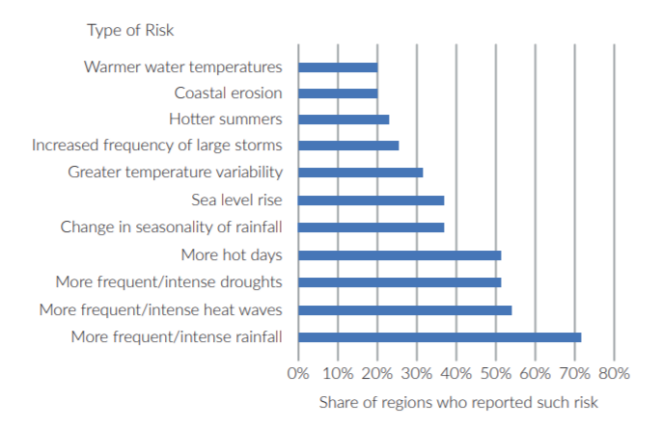
- Regarding the anticipated timescale of the reported risks, the majority (43%) are currently constituting a threat to the regions that reported. 16% will be experienced in the short-term, one-third in the medium term and 8% in the long-term.
- The fact that so many impacts form climate change are already occurring or will occur in the short- to medium-term, makes adaptation a pressing issue for regional governments (figure 2).
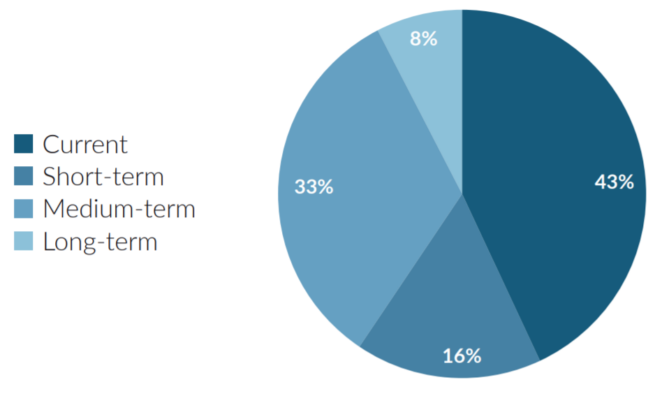
- For the 185 reported physical risks from climate change, only two had not been classified in term of anticipated timescale and impacts seriousness (figure 3).
- Out of the rest, 69% have been classified as serious, 17% as extremely serious, and only 14% as less serious.
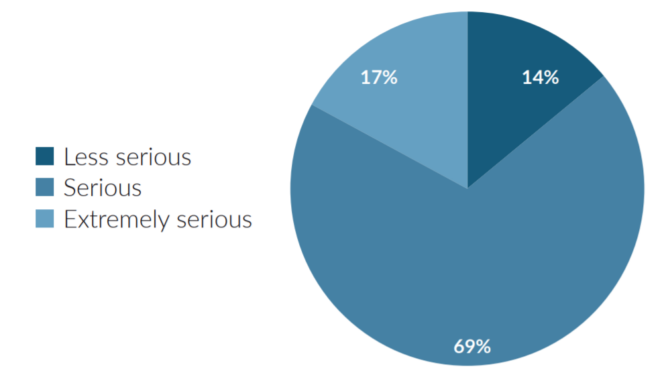
Water supply risks and adaptation at a regional scale
- A number of 35 regions reported on this section of CDP’s platform.
- In most of the regions water supply risks resulting from climate change are experienced, while others could not confirm it as a risk, mainly due to a lack of assessments in this field.
- The majority of the 71 risks to water supply that were reported are considered as serious or extremely serious, with the most common type of risk reported being the increased risk of water stress or scarcity, followed by fourteen reports on declining water quality and the same number for flooding (figure 4).
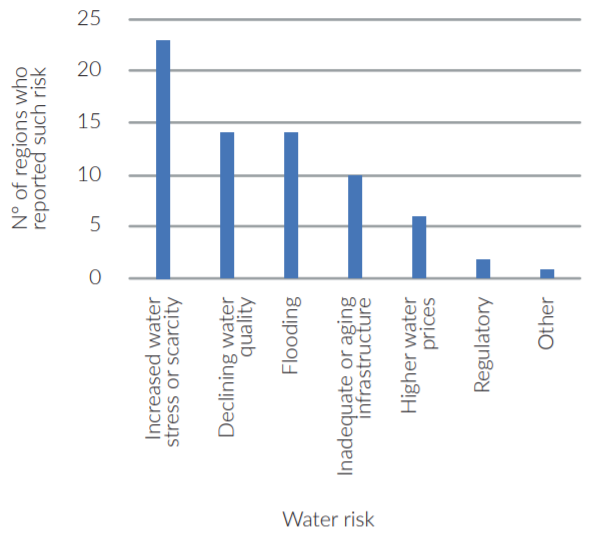
Socio-economic vulnerability from climate change and related adaptation options
- Out of the 38 RegionsAdapt members reporting to CDP’s platform, 32 confirmed they are facing socio-economic risks as result of climate change.
- In total, 97 socio-economic risks have been identified, allocated into 16 categories. The most prominent ones are the risk to already vulnerable populations, health risks and increased incidence and prevalence of diseases (figure 5).
- In addition, the majority of socio-economic risks are already being felt, representing 45% of the 97 reported socio-economic risks, followed by most one-quarter of socio-economic risk expected in medium-term (figure 6).
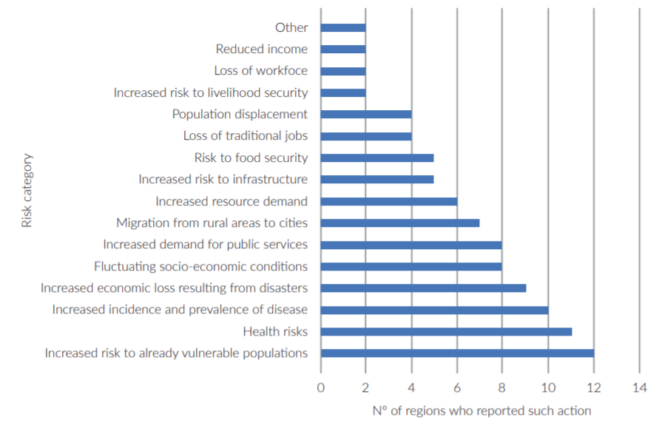
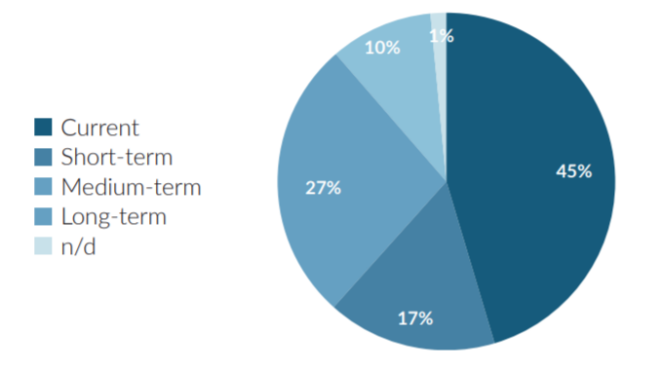
Lessons Learnt
- This report has shown that climate change already threatens regions worldwide and will continue to do so in the future.
- Responding to these threats is crucial in order to reduce vulnerabilities and increase resilience of societies and ecosystems.
- It has been shown that regional governments are taking their responsibility seriously in making the necessary arrangements to mitigate risks from climate change through the development and implementation of adaptation strategies and actions.
- Climate change is being incorporated into more and more regional planning documents, a desirable development, since climate change impacts all areas and sectors.
- Almost all disclosing regional governments work closely with their local counterparts and more than half of them are somehow involved in the development and implementation of national adaptation strategies.
- Climate actions are most effective when national governments support local and regional governments in their efforts.
- However, there are still some obstacles to overcome:
- Carrying out vulnerability assessments is a crucial step in addressing climate risks.
- There are still some regions that lack sufficient data with regards to climate change impacts and therefore they face difficulties in developing adequate adaptation strategies and measures.
- Other challenges for regional governments are the lack of training and education and the lack of financial resources.
Suggested citation
Kupka, S., Pulgarín, V., 2018. RegionsAdapt: 2018 Brief Report. nrg4SD.
(0) Comments
There is no content